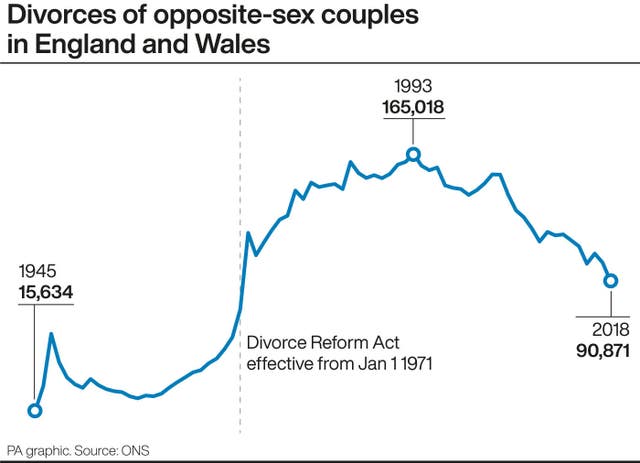/arc-anglerfish-arc2-prod-jerseyeveningpost-mna.s3.amazonaws.com/public/H36SDJ2NMJCLZGYYJV72TOVXK4.jpg)
Divorce rates fall to lowest since 1971
But the number of same sex couples splitting up has risen by more than a quarter, figures show.
Divorce rates for heterosexual couples in England and Wales fell last year to their lowest for nearly half a century – but the number of same sex couples splitting up has risen.
There were 90,871 divorces of opposite-sex couples in 2018 – a drop of 10.6% compared with the previous year (101,669) and the lowest number since 1971 (74,437), the Office for National Statistics (ONS) said.
The divorce rate fell to 7.5 per 1,000 married men and women from 8.4 in the previous year.
Divorcing couples were married for an average of 12-and-a-half years, according to the figures.

But lawyers believed there could be other explanations for the figures.
David Leadercramer, a partner at Osbornes Law who specialises in family cases, said: “More and more people are delaying getting divorced because they are waiting for new legislation that will mean they don’t need to apportion blame.
“While some people can’t delay getting divorced, many are preferring to wait for the new no fault law. This is because they would rather avoid making allegations that inevitably create more confrontation.
“In addition we are also seeing more people struggling to get their divorces over the line as their properties are not worth as much as they thought and in the current uncertain market they are struggling to sell their homes.
“If they are unable to sell what is nearly always their main asset, then that can mean getting divorced becomes a lot more difficult.”
Naomi Rainey, a senior solicitor at Hall Brown Family Law firm, claimed cuts in court funding and problems with online services had caused delays in processing divorce petitions but did not believe they accounted for “such a significant reduction in divorce”.
She added: “I feel that the historic nature of this reduction is more likely to be due to a change in how society regards marriage.
“The fact that divorce is at its lowest since before the last major law reform and that there has been an increase in the average length of marriage indicates a renewed commitment to it.
“The average length of marriages has been increasing over the last two decades, so this data doesn’t necessarily demonstrate an exceptional development as much as a continued pattern.”

Of these, three-quarters (75%) were among lesbian couples, a similar proportion to the previous year.
Divorces among same-sex couples have been recorded since marriage laws changed in 2014.
The ONS said: “Divorces among same-sex couples were first recorded in 2015 and annual increases have been seen each year since then, reflecting growth in the size of the same-sex married population in England and Wales.”
Unreasonable behaviour – which can include infidelity – was cited as the most common reason in all divorces last year.
Some 51.9% of wives and 36.8% of husbands petitioned for divorce on these grounds.
This has consistently been the most common reason for wives petitioning for divorce since the late 1970s and for husbands since 2006, the ONS added.
The figures are calculated using information from courts during divorce proceedings and also look at annulments.
They do not include married couples who separate but do not divorce or dissolutions of civil partnerships, which are recorded in different data.